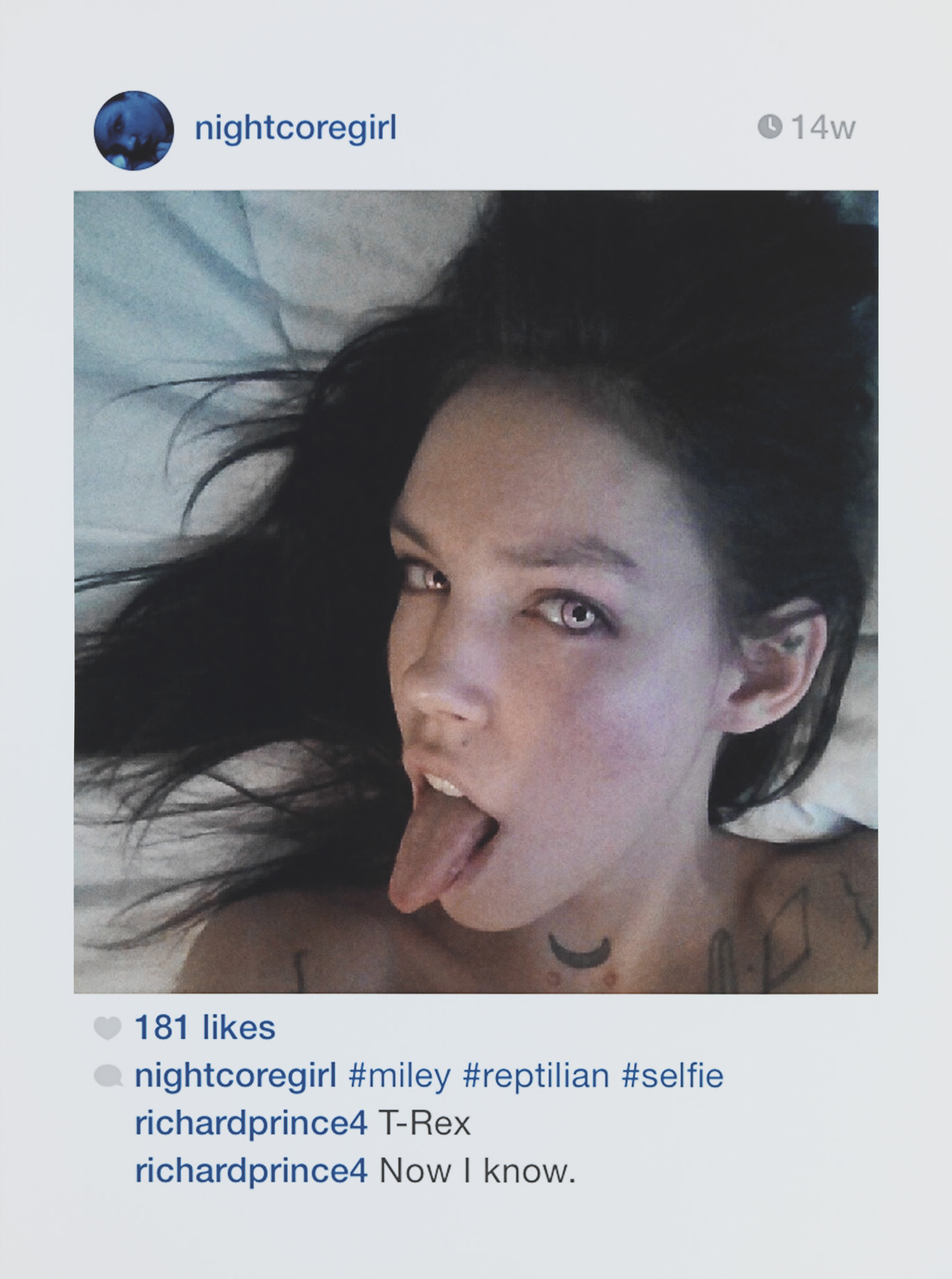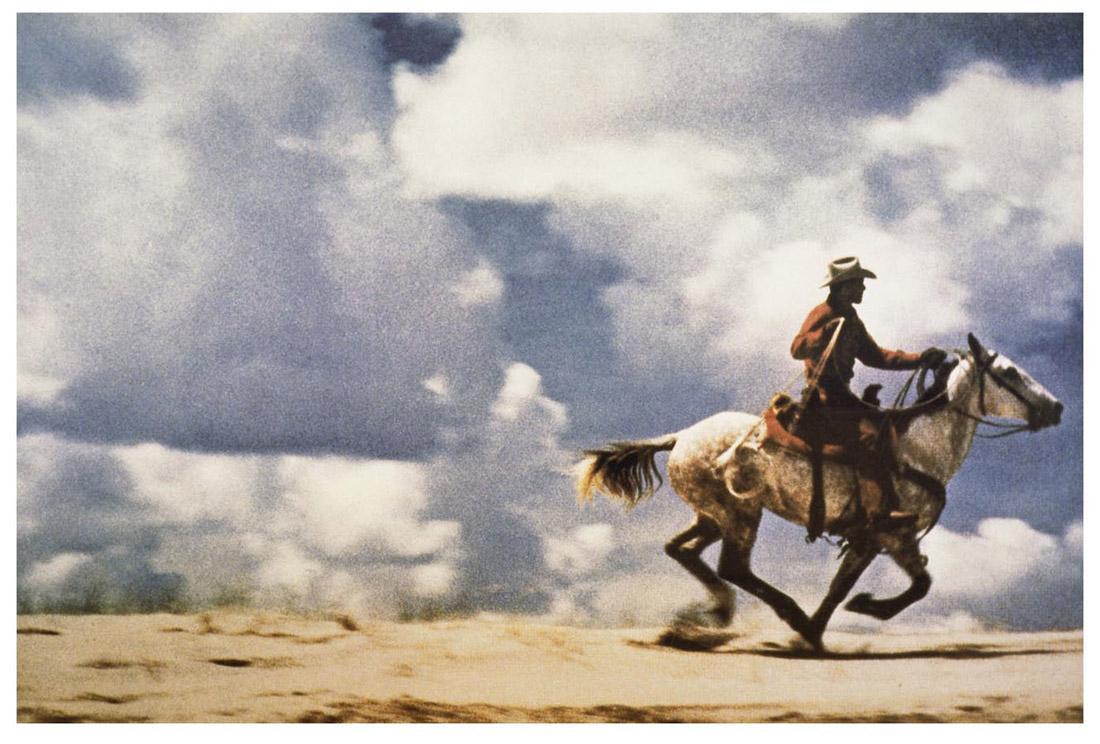Richard Prince has been deconstructing the myths of American consumer culture for 40 years. And despite having returned to the same themes and forms for much of his career, he still has the ability to shock and rile. From lawsuits to police seizures of his work, Prince has left behind a trail of controversy whenever he exhibits his work. So it should come as no surprise that his latest project, New Portraits — which debuted at the Gagosian Gallery last year and was re-exhibited at Frieze New York in May — has created a plethora of comment pieces and the anger that a Richard Prince exhibition doesn’t feel complete without.
If you aren’t aware of the project, Prince finds Instagram images he likes (quite often women, though not exclusively), comments on them, screenshots them, and stretches them out over 6 x 4 canvases. The controversy revolves around a few things: How is this bullshit even art? How dare he make money off other people’s images? And how utterly misogynistic he is, re-appropriating images of women.
The first two criticisms have dogged the art world since forever; critics have derided as charlatans artists as inventive and singular as Manet and Pollock (they can’t paint) to Warhol and Duchamp (you can’t just take things and call them art). The list of things we now deem masterpieces that were ridiculed as not being art when they were first created is too long to compile. And it’s depressing to think we are still engaging in the same, never-ending arguments. Especially as Richard Prince has been doing this for 40 years now.

So yes, it is art. And yes, it is a bit weird that people are willing to pay large amounts of money for art, but capitalism and the art market is hardly Richard Prince’s fault. The SuicideGirls’ stunt of selling identical prints for $90, not $90,000, misses the point of why people are prepared to pay $90,000 for a Richard Prince artwork.
Artists have been mining the detritus of pop culture for their work for over 100 years. Now that internet culture and social media form our generation’s pop cultural detritus, their integration into art is unavoidable. Instagram is a natural wealth of readily available media, its images are analogous to the adverts Prince tore out of Time magazine in the 80s in order to re-photograph them, or the iconography of 50s and 60s America that Warhol reimagined through his screenprints of Elvis, Marilyn Monroe and Mao Tse Tsung.
This leaves us with misogyny, and the question of whether or not Richard Prince is a misogynist. It’s a harder call to make, and a harder accusation to defend him against.
Firstly to assume he is, we must assume that the comments Prince leaves are made with sincerity, a straight face, the genuine creepy idolatry of young women by a rich, white, man in his 60s. But do we really think Richard Prince, upon seeing an image of Kate Moss on his Instagram feed, would comment “Cray flea in dle tray so trust me if bull fly up Chee sez. Sez me!” Or that, below a picture of Sky Ferreira in a car, he would leave a mindless comment like, “Enjoyed the ride today. Let’s do it again. Richard.”
Prince’s comments flitter between creepiness, deadpan humor, appropriation of the language of the internet, screeds of nonsense, emoji, and the stilted formal style of a dad who’s just discovered Facebook. His comments are much like the rest of the comments left under these images, by thousands of other people. Those other Sky Ferreira comments, for example, read: booty-full; hi I follow you; i want one; this is ill; can I have. In New Portraits,Prince is re-appropriating both the language and visual codes of social media.
Why? Well, Prince has always used appropriation to explore the mythology of American pop cultural life, from its seedy sexiness to its prim veneers. He’s re-photographed cowboys, nurses, bikers and gangs all in search of the American Dream. Indeed, his image of a naked, 10-year-old Brooke Shields in make-up and standing suggestively by a bath was titled Spiritual America. It was an image originally commissioned by Brooke’s mother for a soft porn mag to launch her daughter’s career and make her famous. Few things are as entwined in the American dream as sex, exploitation and fame.
The title was taken from a different photograph, by Alfred Stieglitz, of a horse at work in the American west. The image isn’t Prince’s perverse sexual fantasy of a prepubescent girl, but a searing critique of the length Americans will go to be famous or to exploit others (even their daughters) for money. It’s a theme he’s carried on revisiting throughout his work — the intertwining of lust for sex and lust for money in American society. The hypocrisy of a nation that will more readily throw its arms up in rage over a re-photographed image of a naked ten-year-old than show disgust at the fact that her mother is legally able to sexually exploit her.

By re-photographing these images, Prince is creating a distance between the subject and object, the exploited and exploiter, Brooke Shields and her mother’s desire for money. It isn’t Prince being misogynistic, but revealing the misogyny of American society.
Prince has always used the images that make up American culture to subvert it, to show another side of it. His images of motorcycle outlaws show those living on that culture’s fringes, how they visually, ethically, and socially rebelled against the mainstream, good taste and polite manners. His images of cowboys show America’s continued obsession with the individual, making it in the west in a ten-gallon hat and a pair of Levi’s. Yet here they are continually stuck in a Quixotic visual loop of conquering and reconquering America’s frontiers, long after its relevance has dissipated. These are complicated comments on distance, politics, Americanism, capitalism, the iconography of the individual, the individual in society, exploitation, art and sex. They are not simply the pornographic, misogynistic fantasies of a talentless hack.
So it is easier, given the context of Prince’s career, to pull apart this simplistic reading of the New Portraits as misogynistic re-appropriations of women’s bodies. He is, like the cowboys, the bikers, surfers and Brooke Shields, pulling at the visual tropes that make up modern American society. And what better, easier way to do it than through Instagram given the great, visual world that it encapsulates: the willingness of young, beautiful, women, to present themselves to the world and a visual representation of their bodies; the weird below-the-line world of creepy men who comment upon and seek to stake a claim back upon them with a scores of i want yous.
Related: See how Sad Girl artist Audrey Wollen responded when Richard Prince appropriated her Instagram, and what she thought of his latest show.
Credits
Text Felix Petty
